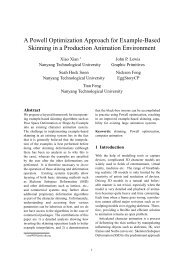A Short SVM (Support Vector Machine) Tutorial ... - JP Lewis
A Short SVM (Support Vector Machine) Tutorial ... - JP Lewis
A Short SVM (Support Vector Machine) Tutorial ... - JP Lewis
Create successful ePaper yourself
Turn your PDF publications into a flip-book with our unique Google optimized e-Paper software.
Reducing α allows more of the data to lie on the wrong side of the hyperplane and be treated as outliers, which gives a smoother<br />
decision boundary.<br />
Kernel trick<br />
With w, b obtained the problem is solved for the simple linear case in which the data are separated by a hyperplane. The “kernel<br />
trick” allows <strong>SVM</strong>s to form nonlinear boundaries. There are several parts to the kernel trick.<br />
1. The algorithm has to be expressed using only the inner products of data items. For a hyperplane test w ′ x this can be done<br />
by recognizing that w itself is always some linear combination of the data x k (“representer theorem”), w = ∑ λ k x k , so<br />
w ′ x = ∑ λ k x k x.<br />
2. The original data are passed through a nonlinear map to form new data with additional dimensions, e.g. by adding the<br />
pairwise product of some of the original data dimensions to each data vector.<br />
3. Instead of doing the inner product on these new, larger vectors, think of storing the inner product of two elements x ′ j x k<br />
in a table k(x j ,x k ) = x ′ j x k, so now the inner product of these large vectors is just a table lookup. But instead of doing<br />
this, just “invent” a function K(x j ,x k ) that could represent dot product of the data after doing some nonlinear map on<br />
them. This function is the kernel.<br />
These steps will now be described.<br />
Kernel trick part 1: dual problem. First, the optimization problem is converted to the “dual form” in which w is eliminated<br />
and the Lagrangian is a function of only λ k . To do this substitute the expression for w back into the Lagrangian,<br />
L = 1 2 w′ w − ∑ λ k (y k (w ′ x k + b) − 1)<br />
w = ∑ λ k y k x k<br />
L = 1 2 (∑ λ k y k x k ) ′ ( ∑ λ l y l x l ) − ∑ λ m (y m (( ∑ λ n y n x ′ n) ′ x m + b) − 1)<br />
= 1 2<br />
∑∑<br />
λk λ l y k y l x ′ kx l − ∑∑ λ m λ n y m y n x ′ mx n − ∑ λ m y m b + ∑ λ m<br />
the term ∑ λ m y m b = b ∑ λ m y m is zero<br />
because dL<br />
db gave ∑ λ m y m = 0 above.<br />
so the resulting dual Lagrangian is L D = ∑ λ m − 1 2<br />
∑ ∑<br />
λk λ l y k y l x ′ k x l<br />
subject to λ k > 0<br />
∑<br />
and λk y k = 0<br />
To solve the problem the dual L D should be maximized wrt λ k as described earlier.<br />
The dual form sometimes simplifies the optimization, as it does in this problem - the constraints for this version are simpler<br />
than the original constraints. One thing to notice is that this result depends on the 1/2 added for convenience in the original Lagrangian.<br />
Without this, the big double sum terms would cancel out entirely! For <strong>SVM</strong>s the major point of the dual formulation,<br />
however, is that the data (see L D ) appear in the form of their dot product x ′ k x l. This will be used in part 3 below.<br />
Kernel trick part 2: nonlinear map. In the second part of the kernel trick, the data are passed through a nonlinear mapping.<br />
For example in the two-dimensional case suppose that data of one class is near the origin, surrounded on all sides by data of the<br />
second class. A ring of some radius will separate the data, but it cannot be separated by a line (hyperplane).<br />
The x, y data can be mapped to three dimensions u, v, w:<br />
u ← x<br />
v ← y<br />
w ← x 2 + y 2<br />
5







